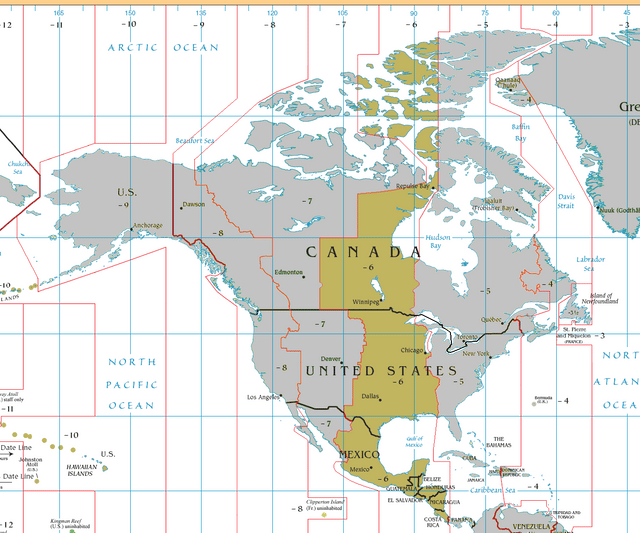Central Time Zone

Central Time Zone

| Central Time Zone (North America) | |
|---|---|
| UTC offset | |
| CST | UTC−06:00 |
| CDT | UTC−05:00 |
| Current time | |
| 13:24, 24 September 2019 CDT[refresh [4] ] | |
| Observance of DST | |
| DST is observed in some of this time zone. | |
The North American Central Time Zone (CT) is a time zone in parts of Canada, the United States, Mexico, Central America, some Caribbean Islands, and part of the Eastern Pacific Ocean.
Central Standard Time (CST) is six hours behind Coordinated Universal Time (UTC). During summer most of the zone uses daylight saving time (DST), and changes to Central Daylight Time (CDT) which is five hours behind UTC.
The largest city in the Central Time Zone is Mexico City; the Mexico City metropolitan area is the largest metropolitan area in the zone and North America.
| Central Time Zone (North America) | |
|---|---|
| UTC offset | |
| CST | UTC−06:00 |
| CDT | UTC−05:00 |
| Current time | |
| 13:24, 24 September 2019 CDT[refresh [4] ] | |
| Observance of DST | |
| DST is observed in some of this time zone. | |
Regions using (North American) Central Time
Canada
The province of Manitoba is the only province or territory in Canada that observes Central Time in all areas.
The following Canadian provinces and territories observe Central Time in the areas noted, while their other areas observe Eastern Time:
Also, most of the province of Saskatchewan is on Central Standard Time year-round, never adjusting for Daylight Saving Time. Major exceptions include Lloydminster, a city situated on the boundary between Alberta and Saskatchewan. The city charter stipulates that it shall observe Mountain Time and DST, putting the community on the same time as all of Alberta, including the major cities of Calgary and Edmonton. As a result, during the summer, clocks in the entire province match those in Alberta, but during the winter, clocks in most of the province match those in Manitoba.
United States
Ten states are contained entirely in the Central Time Zone:
Note: Although all of Alabama is legally on Central Time, Phenix City and the nearby community of Smiths Station unofficially observe Eastern Time, as these areas are part of the metropolitan area of the considerably larger city of Columbus, Georgia in the Eastern Time Zone. Lanett and Valley observe Eastern Time historically because they were textile mill towns and the original home office of their mills was in West Point, Georgia.[1] Also, while Oklahoma is completely in Central Time, the city of Kenton in the northwestern corner of the state informally observes Mountain Time.
Five states are split between the Central Time Zone and the Mountain Time Zone:
Kansas – all, except for Sherman, Wallace, Greeley, and Hamilton counties
Nebraska – eastern two thirds
North Dakota – all, except for southwest regions and south part of McKenzie County, plus the majority of Dunn County and far western Sioux County
South Dakota – eastern half
Texas – all, except for El Paso and Hudspeth counties
Five states are split between the Central Time Zone and the Eastern Time Zone:
Florida – Florida Panhandle below Alabama border (west of the Apalachicola River) and the Dry Tortugas National Park in Monroe County west of the Florida Keys
Indiana – northwest and southwest regions (see Time in Indiana)
Kentucky – western half
Michigan – Gogebic, Iron, Dickinson, and Menominee counties
Tennessee – West Tennessee and Middle Tennessee
Mexico
The federal entities of Mexico that observe Central Time:
Aguascalientes
Campeche
Coahuila
Colima – except for the Revillagigedo Islands, in which the inner islands use Mountain Time and the outer island uses Pacific Time
Chiapas
Durango
Guanajuato
Guerrero
Hidalgo
Morelos
Nayarit – *only the municipality of Bahía de Banderas, rest of the state uses Mountain Time
Oaxaca
Querétaro
San Luis Potosí
State of Mexico
Tabasco
Tamaulipas
Tlaxcala
Yucatán
Zacatecas
Central America
Belize, Costa Rica, El Salvador, Guatemala, Honduras, and Nicaragua all use Central Standard Time year-round.
Eastern Pacific islands and other areas
The Galápagos Islands in Ecuador uses Central Standard Time all year-round; the remainder of Ecuador uses Eastern Standard Time. Both Easter Island and Salas y Gómez Island in Chile uses Central Standard Time during the Southern Hemisphere winter and Central Daylight Time during the Southern Hemisphere summer; the remainder of Chile uses Atlantic Standard Time and Atlantic Daylight Time.
Central Daylight Time
Daylight saving time (DST) is in effect in much of the Central time zone between mid-March and early November. The modified time is called "Central Daylight Time" (CDT) and is UTC−05:00. In Canada, Saskatchewan does not observe a time change. One reason for Saskatchewan's lack of a time change is that, geographically, the entire province is closer to the Mountain Time Zone's meridian. The province elected to move onto "permanent" daylight saving by being part of the Central Time Zone. The only exception is the region immediately surrounding the Saskatchewan side of the biprovincial city of Lloydminster, which has chosen to use Mountain Time with DST, synchronizing its clocks with those of Alberta.
In those areas of the Canadian and American time zones that observe DST, beginning in 2007, the local time changes at 02:00 local standard time to 03:00 local daylight time on the second Sunday in March and returns at 02:00 local daylight time to 01:00 local standard time on the first Sunday in November. Mexico decided not to go along with this change and observes their horario de verano from the first Sunday in April to the last Sunday in October. In December 2009, the Mexican Congress allowed ten border cities, eight of which are in states that observe Central Time, to adopt the U.S. daylight time schedule effective in 2010.
Alphabetical list of major Central Time Zone metropolitan areas
See also
Effects of time zones on North American broadcasting